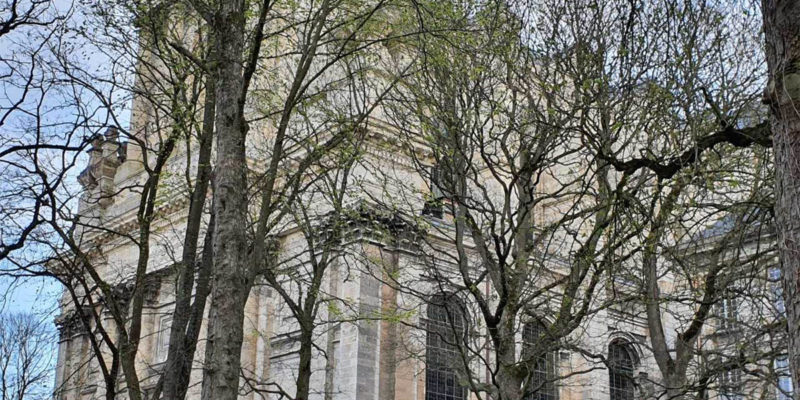The strong hegemonic dimension of the Saint-Vaast Abbey led to strong religious development of the town in the Middle Ages. Much of this began during what historians call the “Querelle des Investitures”, when pontiffs Gregory VII (1073-1085) and Urban II (1088-1099) clashed with secular rulers over the exclusive right to invest candidates for ecclesiastical offices in bishoprics and abbeys. With the death of the bishop of Cambrai on August 12, 1092, the canons of Notre-Dame-en-Cité took the opportunity to claim their autonomy, with the support of the Pope. The diocese developed under Lambert (1094-1115) and Alvise (1131-1147).
A site on the ancient Castrum
Near the remains of Nemetacum, as you go down rue Baudimont, you’ll find a square on the right, which marks the site of the Cité’s former cathedral. This is the very place where Saint-Vaast was buried, as we have mentioned earlier. The most significant constructions and developments of this site trace back to the 11th and 12th centuries, a period of great architectural advancement in the region.
The cathedral underwent a complete reconstruction starting in 1160 AD, a project born out of necessity after a previous church built post-883 was destroyed in a fire in 1030. The initial efforts to rebuild this Romanesque edifice were led by the bishop of Cambrai. The ambitious project stretched over four centuries, experiencing a lengthy hiatus between 1250 and 1372. Despite these interruptions, the construction gradually resumed, and the Gothic transept was finally completed at the end of the 12th century.
The cathedral’s monumental size became a defining feature. It wasn’t until the episcopate of Hugues de Cayeu, who held office from 1426 to 1439, that the large, soaring vaults—reaching an impressive height of 30 meters—were installed. This remarkable architectural feat contributed to the structure’s overall grandeur. Measuring 116 meters in length, it stood as a magnificent edifice, not far off from the dimensions of Notre Dame de Paris, which stretches 132 meters. The cathedral of the Cité was officially consecrated on July 7, 1484, a dozen years following the consecration of the cathedral in Cambrai.
However, the cathedral’s history was not without its trials. In 1571, during the tenure of François Richardot, a bishop of the Augustinian order and also Canon of Besançon, the Gothic cathedral of the City of Arras suffered a devastating fire, marking yet another tumultuous chapter in its storied existence.
The destruction of Notre Dame Cathedral in the Cité d’Arras
The Notre Dame Cathedral in the Cité of Arras was one of the many casualties of the French Revolution, a period marked by widespread destruction and upheaval, particularly towards religious edifices. In this turbulent time, not just Arras, but also other cities in the region saw the loss of their great cathedrals, including those in Boulogne-sur-Mer and Cambrai. Civil unrest and revolutionary fervor had a far-reaching impact on religious sites, and in Arras, this was felt more strongly than in many other places.
Virtually every church and religious building in the area faced damage or repurposing. The Saint-Vaast Abbey, however, managed to escape the widespread destruction due to its transformation into a hospital, offering it a rare immunity amid the chaos. Unfortunately, Notre Dame Cathedral in the Cité of Arras was not so fortunate. Between 1792 and 1793, it fell victim to extensive acts of vandalism. Its once magnificent structure was reduced to a source of building materials as its stones were sold off. A Dutchman by the name of Pierre Vandercoster became notably involved in this trade, profiting from the sale of the cathedral’s remains.
Reduced to a mere shadow of its former self, the cathedral was repurposed as a stable before being finally sold by the municipality in 1799. This marked a turning point in its history, as the former episcopal palace then underwent a significant transformation. Following the sale of the cathedral, the palace was recovered and repurposed, becoming the prefecture of Pas-de-Calais.
In 1801, a further transformation occurred, driven by the influence of Napoleon, who visited Arras in 1802. He ordered the transfer of the episcopal seat to the Palais Saint-Vaast, laying the foundations for the creation of the Cathedral of Notre Dame and Saint Vaast, which stands proudly to this day. The original site of Notre Dame Cathedral in the Cité, however, now houses the Catholic Church of Saint-Nicolas-en-Cité d’Arras, serving as a reminder of the city’s rich, albeit tumultuous, historical legacy.
R.C.
